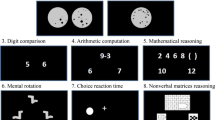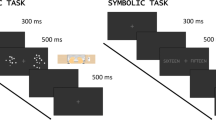Abstract
People use mental number lines for both symbolic numerals and numerosity, but little is known about how these two mental number lines are related. The current study investigated the association in effect size, directionality of the mental number line, and development between symbolic and non-symbolic mental number lines to determine if they were related to or independent from each other. We collected data from numerosity- and digit-matching tasks that used the following numbers: 11, 14, 17, 20, 23, 26, and 29. Tasks were performed by college undergraduates and the fifth-grade primary school students. The results showed that none of the effects for non-symbolic numbers was related to any of the effects for symbolic numbers, and vice versa, in both adults and children. Another notable finding was that the correlation between the SNARC (spatial-numerical association of response code) effect size and mathematical ability was negative in the adult group. These results are consistent with the dissociated processes hypothesis and suggest that mental number lines are notation-dependent. As shown by the SNARC effect, the mental number line might result in interference in the current task by an automatically activated spatial notation-dependent representation of numbers.




Similar content being viewed by others

References
Aulet LS, Lourenco SF (2018) The developing mental number line: does its directionality relate to 5- to 7-year-old children’s mathematical abilities? Front Psychol 9:1142
Beecham R, Reeve RA, Wilson SJ (2009) Spatial representations are specific to different domains of knowledge. PLoS ONE 4(5):e5543
Berch DB, Foley EJ (1999) Extracting parity and magnitude from arabic numerals: developmental changes in number processing. J Exp Child Psychol 74(4):286–286
Bos FVD, Luit JEHV, Kroesbergen EH, Xenidou-Dervou I, Lieshout ECDMV, Schoot MVD et al (2015) Pathways of number line development in children: predictors and risk for adverse mathematical outcome. Ztschrift Für Psycholie 223(2):120–128
Bueti D, Walsh V (2009) The parietal cortex and the representation of time, space, number and other magnitudes. Philos Trans R Soc B Biol Sci 364:1831–1840
Bulf H, de Hevia MD, Macchi Cassia V (2015) Small on the left, large on the right: Numbers orient visual attention onto space in preverbal infants. Dev Sci 19:1–8
Bull R, Cleland AA, Mitchell T (2013) Sex differences in the spatial representation of number. J Exp Psychol Gen 142(1):181–192
Bulthé J, De Smedt B, Op de Beeck HP (2014) Format-dependent representations of symbolic and non-symbolic numbers in the human cortex as revealed by multi-voxel pattern analyses. NeuroImage (Orlando, Fla.) 87:311–322. https://doi.org/10.1016/j.neuroimage.2013.10.049
Butterworth B (1999) The mathematical brain. Macmillan, London
Cipora K, Nuerk H (2013) Is the snarc effect related to the level of mathematics? No systematic relationship observed despite more power, more repetitions, and more direct assessment of arithmetic skill. Q J Exp Psychol 66(10):1974–1991
Cipora K, Hohol M, Nuerk H, Willmes K, Brożek B, Kucharzyk B, Nęcka E (2016) Professional mathematicians differ from controls in their spatial–numerical associations. Psychol Res 80(4):710–726
Cipora K, Patro K, Nuerk HC (2015) Are spatial–numerical associations a cornerstone for arithmetic learning? The lack of genuine correlations suggests no. Mind Brain Educ 9(4):190–206
Cooperrider K, Marghetis T, Núñez R (2017) Where does the ordered line come from? Evidence from a culture of Papua New Guinea. Psychol Sci 28(5):599–608
Crollen V, Noël M (2015) Spatial and numerical processing in children with high and low visuospatial abilities. J Exp Child Psychol 132:84–98
Cui J, Xiao R, Ma M, Yuan L, Kodash RC, Zhou X (2020) Children skilled in mental abacus show enhanced non-symbolic number sense. Curr Psychol. https://doi.org/10.1007/s12144-020-00717-0
de Hevia MD, Girelli L, Addabbo M, Cassia VM (2014) Human infants' preference for left-to-right oriented increasing numerical sequences. PloS One 9(5):e96412
Dehaene S, Bossini S, Giraux P (1993) The mental representation of parity and number magnitude. J Exp Psychol Gen 122(3):371–396
Fischer MH, Shaki S (2014) Spatial associations in numerical cognition—from single digits to arithmetic. Q J Exp Psychol 67:1461–1483
Galen MSV, Reitsma P (2008) Developing access to number magnitude: a study of the snarc effect in 7- to 9-year-olds. J Exp Child Psychol 101(2):99–113
Galton F (1880) Visualised numerals. Nature 21:494–495
Gashaj V, Uehlinger Y, Roebers CM (2016) Numerical magnitude skills in 6-years-old children: exploring specific associations with components of executive function. J Educ Dev Psychol 6(1):157
Gashaj V, Oberer N, Mast FW, Roebers CM (2019) Individual differences in basic numerical skills: the role of executive functions and motor skills. J Exp Child Psychol 182:187–195
Gazes RP, Diamond RFL, Hope JM, Caillaud D, Stoinski TS, Hampton RR (2017) Spatial representation of magnitude in gorillas and orangutans. Cognition 168:312–319
Geary DC, Hoard MK, Byrd-Craven J, DeSoto MC (2004) Strategy choices in simple and complex addition: contributions of working memory and counting knowledge for children with mathematical disability. J Exp Child Psychol 88:121–151
Halberda J, Mazzocco MM, Feigenson L (2008) Individual differences in non-verbal number acuity correlate with maths achievement. Nature 455(7213):665–668
Hoffmann D, Mussolin C, Martin R, Schiltz C, Lappe M (2014) The impact of mathematical proficiency on the number-space association. Plos One 9(1):e85048
Hutchison JE, Ansari D, Zheng S, De Jesus S, Lyons IM (2020) The relation between subitizable symbolic and non‐symbolic number processing over the kindergarten school year. Dev Sci 23(2):e12884. https://doi.org/10.1111/desc.12884
IBM Corp. Released (2010) IBM SPSS statistics for windows, version 190. IBM Corp, Armonk
Lafay A, St-Pierre M, Macoir J (2017) The mental number line in dyscalculia: Impaired number sense or access from symbolic numbers? J Learn Disabil 50(6):672–683
Landerl K, Bevan A, Butterworth B (2004) Developmental dyscalculia and basic numerical capacities: a study of 8–9-year-old students. Cognition 93(2):99–125
LeFevre JA, Fast L, Skwarchuk SL, Smith-Chant BL, Bisanz J, Kamawar D, Penner-Wilger M (2010) Pathways to mathematics: Longitudinal predictors of performance. Child Dev 81(6):1753–1767
Nathan MB, Shaki S, Salti M, Algom D (2009) Numbers and space: associations and dissociations. Psychon Bull Rev 16(3):578–582
Nieder A, Dehaene S (2009) Representation of number in the brain. Annu Rev Neurosci 32:185–208
Patro K, Haman M (2012) The spatial–numerical congruity effect in preschoolers. J Exp Child Psychol 111(3):534–542
Patro K, Shaki S (2016) SNARC for numerosities is modulated by comparative instruction (and resembles some non-numerical effects). Cognit Process 17(2):127–137
Peters L, Polspoel B, Op de Beeck H, De Smedt B (2016) Brain activity during arithmetic in symbolic and non-symbolic formats in 9–12 year old children. Neuropsychologia 86:19–28. https://doi.org/10.1016/j.neuropsychologia.2016.04.001
R Core Team (2014) R: a language and environment for statistical computing. R Foundation for Statistical Computing, Vienna http://www.R-project.org/
Ren P, Nicholls MER, Ma YY, Chen L (2011) Size matters: non-numerical magnitude affects the spatial coding of response. Plos One 6(8):e23553
Restle F (1970) Speed of adding and comparing numbers. J Exp Psychol 83(2):274–278
Sasanguie D, De Smedt B, Reynvoet B (2017) Evidence for distinct magnitude systems for symbolic and non-symbolic number. Psychol Res 81(1):231–242
Schneider M, Grabner RH, Paetsch J (2009) Mental number line, number line estimation, and mathematical achievement: their interrelations in grades 5 and 6. J Educ Psychol 101(2009):359–372
Shaki S, Fischer MH, Petrusic WM (2009) Reading habits for both words and numbers contribute to the snarc effect. Psychon Bull Rev 16(2):328–331
Shepard RN, Metzler J (1971) Mental rotation of three-dimensional objects. Science 171:701–703
Siegler RS, Ramani GB (2009) Playing linear number board games-but not circular ones-improves low-income preschoolers’ numerical understanding. J Educ Psychol 101(3):545–560
Wei W, Yuan H, Chen C, Zhou X (2012) Cognitive correlates of performance in advanced mathematics. Br J Educ Psychol 82(1):157–181
Wood G, Nuerk H, Willmes K (2006) Variability of the SNARC effect: systematic interindividual differences or just random error? Cortex 42(8):1119–1123
Wood G, Willmes K, Nuerk HC, Fischer MH (2008) On the cognitive link between space and number: a meta-analysis of the SNARC effect. Psychol Sci Q 50:489–525
Yates M, Nemeh F, Loetscher T, Ma-Wyatt A, Nicholls ME (2013) Numerosity is represented spatially: evidence from a’SNARC’task. Percept ECVP Abstr 42:132–132
Zebian and Samar (2005) Linkages between number concepts, spatial thinking, and directionality of writing: the snarc effect and the reverse snarc effect in English and Arabic monoliterates, biliterates, and illiterate Arabic speakers. J Cognit Cult 5(1):165–190
Zhang Y, Liu T, Chen C, Zhou X (2019) Visual form perception supports approximate number system acuity and arithmetic fluency. Learn Individ Differ 71:1–12
Zhou X, Cheng D (2015) When and why numerosity processing is associated with developmental dyscalculia. In: The Routledge international handbook of dyscalculia and mathematical learning difficulties, pp. 78–89
Zhou X, Chen C, Chen L, Dong Q (2008) Holistic or compositional representation of two-digit numbers? Evidence from the distance, magnitude, and SNARC effects in a digit-matching task. Cognition 106:1525–1536
Zhou X, Shen C, Li L, Li D, Cui J (2016) Mental numerosity line in the human’s approximate number system. Exp Psychol 63(3):169–179
Zhou X, Wei W, Zhang Y, Cui J, Chen C (2015) Visual perception can account for the close relation between numerosity processing and computational fluency. Front Psychol 6:1364
Zorzi M, Priftis K, Umilta C (2002) Brain damage—neglect disrupts the mental number line. Nature 417:138–139
Acknowledgments
This research was supported by the 111 Project (Grant number BP0719032).
Author information
Authors and Affiliations
Corresponding author
Ethics declarations
Conflict of interest
XH, PG, SL, XS, and XZ declare that they have no conflicts of interest.
Ethical approval
All procedures performed in studies involving human participants were in accordance with the ethical standards of the institutional and national research committee and with the 1964 Helsinki Declaration and its later amendments or comparable ethical standards. The study was approved by the institutional review board at the State Key Laboratory of Cognitive Neuroscience and Learning, Beijing Normal University.
Informed consent
Informed consent was obtained from all individual participants included in the study.
Additional information
Publisher's Note
Springer Nature remains neutral with regard to jurisdictional claims in published maps and institutional affiliations.
Handling Editor: Juan Lupiáñez (University of Granada); Reviewers: Venera Gashaj (ETH Zurich), Pom Charras (University Paul Valery Montpellier).
Rights and permissions
About this article
Cite this article
He, X., Guo, P., Li, S. et al. Non-symbolic and symbolic number lines are dissociated. Cogn Process 22, 475–486 (2021). https://doi.org/10.1007/s10339-021-01019-4
Received:
Accepted:
Published:
Issue Date:
DOI: https://doi.org/10.1007/s10339-021-01019-4



